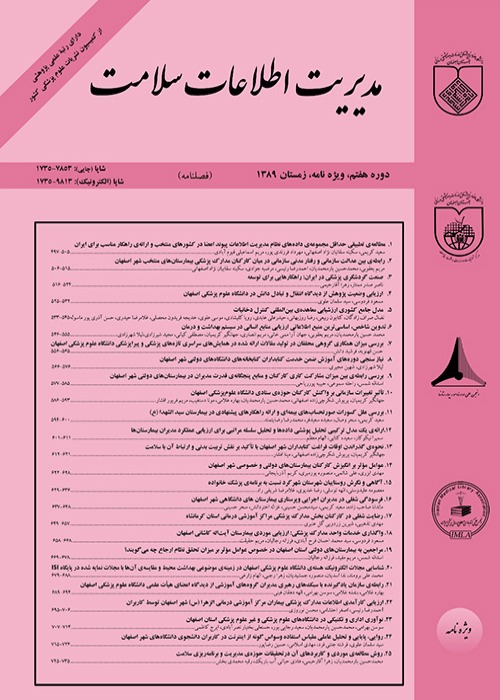Designing a Health System Performance Assessment Model for Iran
Author(s):
Abstract:
Introduction
Health system performance assessment provides appropriate information about the status of health systems for governments and communities. Therefore, in the recent decade, many countries have focused on performance assessment and reporting in order to develop methods and tools as a mean to help achieving health goals. The present study tries to design an indicator-based model (including general aspects and related indicators) for health system assessment in Iran.Methods
This descriptive comparative applied research was carried out during 2008-2009 and included three phases: reviewing theoretical concepts, preparing health system performance assessment indicators draft and building consensus. Required data was collected via environmental scanning and face to face and web-based interviewing. Environmental scanning did not include a study population and the models extracted through this stage were used as information sources. However, the study population during interview and building consensus phases consisted of 31 Iranian health system experts. The reliability and validity of forms used in interviews were confirmed by the experts and test-retest, respectively. We used a purposive approach and opportunistic sampling method to determine the interviewees. Modified Delphi technique was utilized for building consensus. In order to analyze the data, descriptive statistics (percent, mean and standard deviation) was applied. In the environmental scanning stage of research, performance assessment initiatives were identified in Canada, Australia, New Zealand, the United Kingdom and the United States. In addition, transnational performance assessment frameworks of the World Health Organization (WHO), Organization for Economic Cooperation and Development (OECD), the International Organization for Standardization (ISO), Commonwealth Fund and the United States Agency for International Development (USAID) were reviewed and existing indicators in Iran were collected. In the interviewing stage, indicators proposed by the interviewees were obtained. Finally, all identified indicators were classified in 31 criteria to form the initial draft of indicators. Results
For consensus building, 2 processes of modified Delphi were conducted. In the first process, after 4 rounds, 14 criteria were selected for Iranian health system performance assessment including public health status, governance, accessibility, health expenditure, financing and equity, primary health care, aging care, quality of services, insurance system, hospital performance, research and development, privatization, efficiency and productivity, technology and health information system and also health outcomes. In the second process of Delphi, consensus was obtained on 175 indicators.Conclusion
The designed result- and indicator–based model provides an instrument for reviewing country's health system. Applying this model will offer policy–makers a major opportunity for performance improvement over time.Language:
Persian
Published:
Health Information Management, Volume:8 Issue: 3, 2011
Page:
285
magiran.com/p919060
دانلود و مطالعه متن این مقاله با یکی از روشهای زیر امکان پذیر است:
اشتراک شخصی
با عضویت و پرداخت آنلاین حق اشتراک یکساله به مبلغ 1,390,000ريال میتوانید 70 عنوان مطلب دانلود کنید!
اشتراک سازمانی
به کتابخانه دانشگاه یا محل کار خود پیشنهاد کنید تا اشتراک سازمانی این پایگاه را برای دسترسی نامحدود همه کاربران به متن مطالب تهیه نمایند!
توجه!
- حق عضویت دریافتی صرف حمایت از نشریات عضو و نگهداری، تکمیل و توسعه مگیران میشود.
- پرداخت حق اشتراک و دانلود مقالات اجازه بازنشر آن در سایر رسانههای چاپی و دیجیتال را به کاربر نمیدهد.
In order to view content subscription is required
Personal subscription
Subscribe magiran.com for 70 € euros via PayPal and download 70 articles during a year.
Organization subscription
Please contact us to subscribe your university or library for unlimited access!



